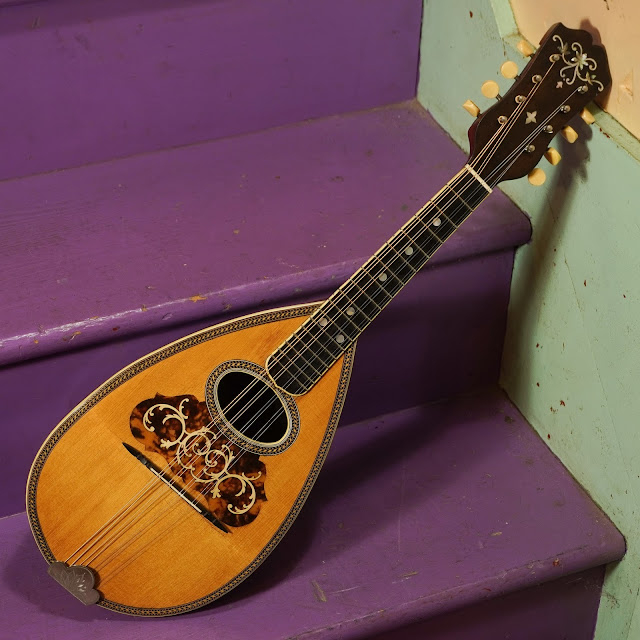1890s AC Fairbanks Model 120 Bowlback Mandolin
I like fancy mandolins! This one's a Boston-made AC Fairbanks and its model number (120) is on the back of the headstock. This looks an awful lot like a Vega-made product to me, but I suppose it could be a Fairbanks homebrew. I get pretty confused with their business arrangements around this time (this one's probably right around 1895).
It's a many-ribbed, high-grade bowlback and has some nice bling via purfling and inlay in the top and at the headstock. Its voice is sweet, clean, clear, loud, and has a lot of sustain. It's got bar frets and more-quality-than-usual tuners and engraved coverplates and an engraved tailpiece cover.
There was some funk to work around (loose braces, a displaced endblock/side seam issue), but now that it's done-up it's healthy and playing like a champ.
Repairs included: fret level/dress, hairline crack sealing (it'd already been cleated), two brace reglues, side dots install, bridge adjustments (bottom shim and mild compensation), internal reinforcement to endblock/top meeting area, restring, and setup.
Top wood: solid spruce
Back & sides wood: solid Brazilian rosewood
Bracing type: ladder, one angled brace
Bridge: ebony with bone
Fretboard: ebony
Neck wood: mahogany
Action height at 12th fret: 1/16" overall (hair-under treble, plays perfectly)
String gauges: 32w, 20w, 13, 9 low to high (go no heavier)
Neck shape: medium softened V
Board radius: flat
Neck relief: straight
Fret style: small-medium bar stock
Scale length: 13 1/4"
Nut width: 1 3/16"
Body width: 7 3/4"
Body depth: 5 1/2"
Weight: 1 lb 8 oz
Condition notes: it has a repaired hairline crack on the lower bout. There's mild usewear and finish wear throughout. It's all-original save that the bridge has a shim-foot added to it and the tailpiece "bit into" the neckblock area and the top/side seam next to it is a little disheveled. I've repaired that section, however, though you can see it in the pics.



















Comments